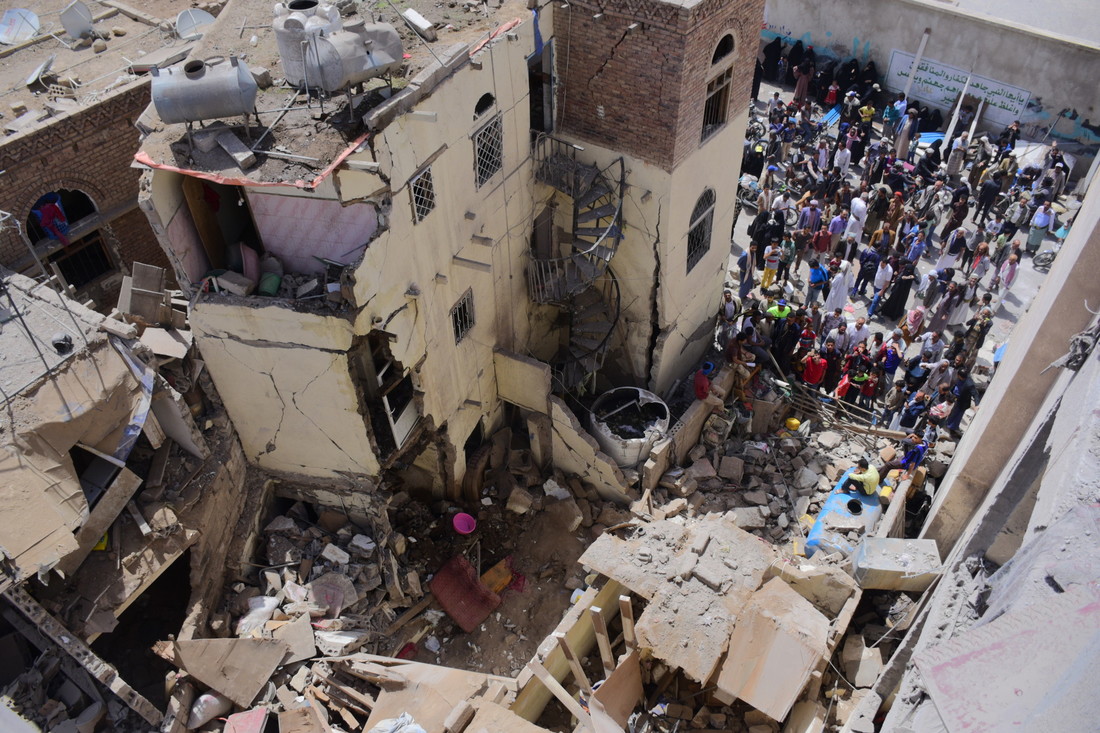- 4 min read
- Published: 7th August 2019
Time for G7 to End the War in Yemen
On 9 August 2018, a 500lb GBU-12 Paveway II laser guided bomb was dropped by the Royal Saudi Air Force on a school bus in Dahyan, Sa-ada Governorate of northern Yemen killing 40 boys aged between six and eleven. They were on a trip, excited, playing together, seemingly happy despite the war that has dominated their lives for over four years. [1] 11 adults were also killed. This brutal act was one of over 50 attacks on civilian vehicles recorded by Human Rights Watch in Yemen during 2018.[2,3]
This is part of a pattern in four years of war where civilians have borne the brunt of the fighting. The Armed Conflict Location and Event Data Project (ACLED)[4] reports nearly 4,500 direct civilian targeting events resulting in approximately 11,700 reported civilian fatalities since March 2015. Over 8000 of those civilian casualties come from airstrikes launched by Saudi Arabia and its allies in the war on Houthi rebel forces.[5]
And it’s not just the bombs. Imports of food, fuel and other goods have fallen because of the fighting. Access to food aid is difficult, and prices in markets have risen greatly because of the war. Save the Children estimated last year that 85,000 Yemeni children may have died of starvation since 2015 – far more than have been killed by guns or bombs.[6] Cholera has killed over 2500 people in Yemen, and 58% of those victims were children.[7] Clean water is barely available in Yemen as airstrikes have destroyed water purification and piping stems. These casualties are as much victims of the war as those killed directly by the fighting.
Being careless as to whether civilians are hurt by military action isa serious violation of International Humanitarian Law (IHL), and deliberately targeting civilians is a war crime, and western governments that back the Saudi-UAE-led Coalition say the Saudis are investigating such incidents. But by 2018, out of thousands of attacks, the Coalition Joint Incidents Assessment Team (JIAT) created to investigate such bombings said it had looked at only 79. [8]Worse, in 2015, the Coalition had declared Sa-ada, a city home to 100,000 civilians one giant military target, something that was raised before the UK Court of Appeal in the case relating to the illegality of UK arms sales to Saudi Arabia under the Arms Trade Treaty and UK law.

Destruction of civilian houses that were hit during airstrike raids in Sana’a. Photo Credit: Bassam Al-Thulaya / Oxfam Yemen
And that’s the crux of the matter. The G7 nations (Canada, France, Germany, Italy, Japan, the United Kingdom, and the United States) who meet this month sell tens billions of dollars’ worth of arms each year to Saudi coalition members. The US is the biggest supplier, with major coalition partners.
Saudi Arabia, the UAE and Egypt receiving some $19.5bn in arms deliveries from the US since 2015. [9] The UK has licensed well over £5.3bn in arms sales to Saudi Arabia alone since 2015. Even a relatively small player like Canada sold CAN$1.2bn to Saudi Arabia in 2018, with a massive CAN$15bn contract for armoured vehicles pending.
It’s not just the bombs, planes and other arms, The UK, through both Ministry of Defence and major contractor BAE Systems retains over 7000 personnel in Saudi Arabia, supporting and maintaining the Royal Saudi Air Force.[10] Under contracts and agreements that date back to the 1980s, UK personnel maintain planes and support military operations. The government denies knowledge of what is going on, maintaining an arm’s length relationship despite years of war crimes committed by Saudi Arabia in Yemen. Since 2008 British personnel have not directly loaded bombs onto planes for combat operations, but oversee and support Saudi personnel to do this. They also service the planes which need continuous maintenance to remain operational. According to UK civil servants and BAE Systems personnel, the coalition “, absolutely depend on BAE Systems” and, if the outside support stopped, couldn’t continue the war after “seven to fourteen days”.
So egregious are the breaches and violations of IHL that Germany (a partner with the UK in building Tornado and Typhoon aircraft used by Saudi Arabia) has withdrawn support for the export of spare parts to the Saudis. The highest Belgian court has ruled 20 arms export licences to Saudi Arabia illegal. The Italian Parliament has voted to stop sales to Saudi Arabia. The UK Court of Appeal has also ruled UK arms sales to Saudi Arabia illegal.
The G7 nations claim to lead the world, they will undoubtedly deplore the continuing fighting and human suffering in Yemen. But the stark truth is that without them the war would have been over years ago. While they continue to fuel the conflict there is no chance that peace can prevail, and Yemenis of all ages will continue to the price of this with their lives.
[1] https://edition.cnn.com/2018/08/13/middleeast/yemen-children-school-bus-strike-intl/index.html
[4] See more detail at https://www.acleddata.com/?s=Yemen.
[6] McKernan, Bethan (21 November 2018). "Yemen: up to 85,000 young children dead from starvation". The Guardian. Retrieved 22 November 2018. https://www.theguardian.com/world/2018/nov/21/yemen-young-children-dead-starvation-disease-save-the-children
[7] Federspiel F, Ali M (December 2018). "The cholera outbreak in Yemen: lessons learned and way forward". BMC Public Health (Review). 18 (1): 1338. doi:10.1186/s12889-018-6227-6. PMC 6278080. PMID 30514336
[8] https://theintercept.com/2018/08/24/yemen-airstrikes-saudi-us-coalition/
9 Figures from securityassistance.org
